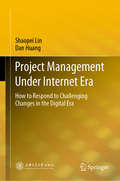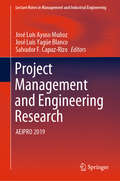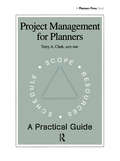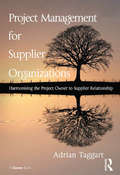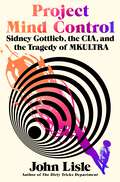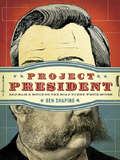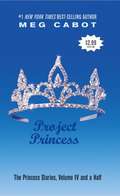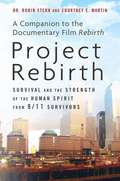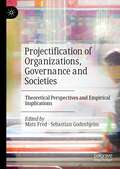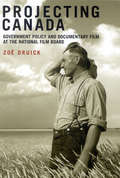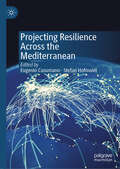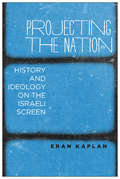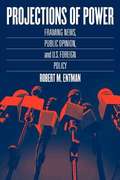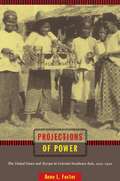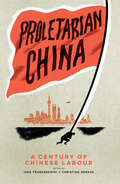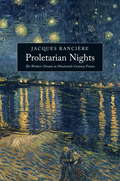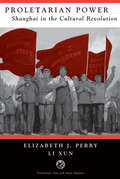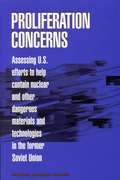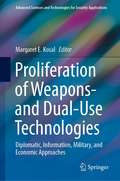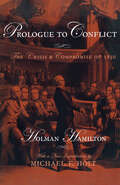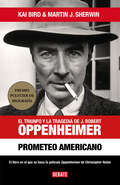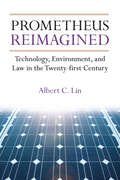- Table View
- List View
Project Management Under Internet Era: How to Respond to Challenging Changes in the Digital Era
by Shaopei Lin Dan HuangTaking account of modern digital era, the emergence of Internet has brought a new scenario of ecology in project management (PM), its methodology, platform, procedures and tools are subjected to subversive changes. So a monograph of Project Management Under Internet Era is urgently needed for renewing concepts in our PM community. The concept of how PM is implemented on the virtual platform through Internet, which is widely used in PM community based on knowledge economy; meanwhile, it is different from former industrial economy with solid assets as its resources and run the project on a real physical manner. Beside the traditional PM, this book presents how shall we accommodate to conventional PM and also accommodate to Internet environment, it also discusses program management and portfolio management under Internet as well as the challenges of PM in the future. From strategic point of view, talent cultivation is extremely critical to PM development,we need to cultivate our talents accommodating to the digital era and on the "Internet +" platform. This is the impetus and the reason of why this monograph is initiated, which can be used as the textbook for graduate and undergraduate students in related majors, also a reference book to the practitioners, who are working on PM under Internet digital era.
Project Management and Engineering Research: AEIPRO 2019 (Lecture Notes in Management and Industrial Engineering #0)
by José Luis Ayuso Muñoz José Luis Yagüe Blanco Salvador F. Capuz-RizoThis book gathers the best papers presented at the International Congress on Project Management and Engineering, in its 2017 and 2018 editions, which were held in Cádiz and Madrid, Spain. It covers a range of topic areas, including civil engineering and urban planning, product and process engineering, environmental engineering, energy efficiency and renewable energies, rural development, information and communication technologies, and risk management and safety.
Project Management for Planners: A Practical Guide
by Terry A. ClarkThis book provides practicing planners with the knowledge of how to bring real world planning projects to a successful and efficient. It applies the five process groups of project management as identified in Project Management Institute's PMBOK® Guide and put them in the language of planners.
Project Management for Supplier Organizations: Harmonising the Project Owner to Supplier Relationship
by Adrian TaggartConventionally, the literature on project management presents the story from the project client, or Owner’s, perspective. Project Management for Supplier Organizations turns this on its head and explores the challenges and remedies from the perspective of the vendors providing the necessary goods and services to a project. It explains the likely impact on the structure, culture, and procedures of Suppliers and identifies the additional competences they may require. It offers new insights, frameworks and models, in particular a new Supplier Organization’s Project Lifecycle Model, that integrate the role of the Supplier as a member of the Owner’s project team with their own necessary commercial activities such as marketing and selling. For Suppliers, this unlocks the contents of the various Bodies of Knowledge, by showing how and where the tools and techniques of project management apply to their particular role. The text explores in some detail the shared and divergent interests of Suppliers and Owners and shows how a well thought-out and carefully executed procurement process maximises the former and diminishes the latter. Such an insight is equally valuable for any Owner Organization. Adrian Taggart’s book provides a refreshing and essential perspective. For Suppliers managing their role in a project, it offers a real insight and an urgent set of priorities. For Owners it shows how best they can work with their suppliers to mutual benefit.
Project Management in Health and Community Services: A contemporary guide to practice
by Judith Dwyer Valerie Thiessen Zhanming LiangThe new edition of this best-selling text presents the tools and techniques for effectively managing every kind of development and change in health and community services, while also balancing the needs of a range of stakeholders. It offers practical, problem-solving strategies based on real-life scenarios.A core competency for health and community service practitioners internationally, project management is a key challenge for both new and existing staff. This practitioner’s guide uses project stories and examples to illustrate the core challenges that practitioners may face, including managing the project life cycle, project planning, execution and evaluation, risk management, handling change and building effective teams. Alongside new interviews with staff working across a range of sectors, this edition includes new content on career development and pathways as well as the growing integration of project methods into general management, and the impact of broader changes like digital innovation and transformation.Written by highly experienced authors, and underpinned by the latest research, this enlightening and practical guide is an essential resource for anyone studying or working in health and community services.
Project Mind Control: Sidney Gottlieb, the CIA, and the Tragedy of MKULTRA
by John LisleThe inside story of the CIA’s secret mind control project, MKULTRA, using never-before-seen testimony from the perpetrators themselves.Sidney Gottlieb was the CIA’s most cunning chemist. As head of the infamous MKULTRA project, he oversaw an assortment of dangerous—even deadly—experiments. Among them: dosing unwitting strangers with mind-bending drugs, torturing mental patients through sensory deprivation, and steering the movements of animals via electrodes implanted into their brains. His goal was to develop methods of mind control that could turn someone into a real-life “Manchurian candidate.” In conjunction with MKULTRA, Gottlieb also plotted the assassination of foreign leaders and created spy gear for undercover agents. The details of his career, however, have long been shrouded in mystery. Upon retiring from the CIA in 1973, he tossed his files into an incinerator. As a result, much of what happened under MKULTRA was thought to be lost—until now.Historian John Lisle has uncovered dozens of depositions containing new information about MKULTRA, straight from the mouths of its perpetrators. For the first time, Gottlieb and his underlings divulge what they did, why they did it, how they got away with it, and much more. Additionally, Lisle highlights the dramatic story of MKULTRA’s victims, from their terrible treatment to their dogged pursuit of justice.The consequences of MKULTRA still reverberate throughout American society. Project Mind Control is the definitive account of this most disturbing of chapters in CIA history.
Project President
by Ben ShapiroProject President is a hilarious romp through American electoral history. From short, fat, bald John Adams' wig-throwing tantrums during the 1800 election to Abraham Lincoln's decision to grow a beard in 1860; from John F. Kennedy's choice to forgo the fedora at his inauguration to John Kerry's decision to get Botoxed for the 2004 race; from the Golden Age of Facial Hair (1860-1912) to the Age of the Banker (1912-1960); from Washington's false teeth to George W. Bush's workout regimen, Project President tells the story of America's love affair with presidential looks and appearance, why that often matters more than a politico's positions on the issues, and what might well be coming next. "I'm constantly citing the power of dress. It's semiology: our clothes send a message about how we want to be perceived, and where is this more powerful and evident than in elected offices. In Project President, Ben Shapiro captures presidential semiotics with a potent narrative and deft analysis. It's simultaneously fascinating and hilarious!"-Tim GunnProject Runway, Liz Claiborne, Inc. "Ben Shapiro takes a romp through American history and shows how personality--and even haircuts--have elected or defeated presidential candidates. It's a tour through history that fans of both parties will enjoy-and can learn from."-Michael BaroneResident scholar, American Enterprise InstituteSenior Writer, U.S. News & World ReportCo-author, The Almanac of American Politics "Presidential politics has always been more superficial than we'd like to admit. With a stylish and likeable touch befitting a strong candidate, Ben Shapiro takes us deep into the shallowness that has shaped American history."-Jonathan AlterNewsweek "Shapiro deftly explains how height, hair and handsomeness can affect a candidate's campaign as much as issues. A fun, informative read." -Glenn BeckNationally syndicated talk show hostHost of CNN's The Glenn Beck Show "A hilarious and illuminating journey through America's centuries-long fascination with presidential image-making. Whether you're left, right, moderate or apathetic, this lively book will get you ready for the packaging of the '08 races."-Jim Hightower "This is a perceptive, witty-sometimes hilarious-look at the realities behind the faces and the facades, the slogans and the character assassinations, of each presidential campaign from George Washington to today - with much for us to ponder for tomorrow." -Sir Martin GilbertOfficial biographer of Winston Churchill "An entertaining and illuminating romp through the politics of symbolism and personality in our presidential politics. If you're thinking of running for president, read this book before you spend a dime on a political consultant."-Rich LowryNational Review COLMES: Who do you want [for the Supreme Court]? ANN COULTER: Thank you for asking. I want Ben Shapiro. COLMES: Ben Shapiro. ANN COULTER: Yes. He just finished his first year at Harvard Law, 21 years old. COLMES: You mean for a date or for the court? ANN COULTER: No, for the court. He's my candidate. He's very bright. He's already written one best-selling book. (CROSSTALK) COLMES: You want to put a 21-year-old guy on the court? ANN COULTER: Twenty-one, and he's just finished first year of Harvard Law. COLMES: So you want someone who's going to be on the court for 50, 60 years? Is that - is that the whole idea? ANN COULTER: No, I just happen to like Ben Shapiro. Hannity and Colmes Fox News ChannelJuly 8, 2005
Project Princess (The Princess Diaries Volume IV and a Half)
by Meg CabotFrom the back cover: "Hammer in hand, Princess Mia embarks on an epic adventure for one so admittedly unhandy: Along with her cohorts from school, she's off to build houses for the less fortunate. It doesn't take Mia long to realize that helping others -- while an unimpeachably noble pastime -- is very hard work. Will her giving spirit prevail? Will the house collapse due to royally clumsy construction? And most importantly, will Michael stop working long enough to kiss her?"
Project Rebirth: Survival and the Strength of the Human Spirit from 9/11 Survivors
by Courtney E. Martin Robin SternEach year, every year, on the anniversary of the attacks, Jim Whitaker and his film crew interviewed eight people who were directly affected by the events of 9/11. They used five of these subjects and their words as the basis for the documentary Rebirth, which premiered at the Sundance Film Festival in 2011. Based on the film, the book Project Rebirth allows the powerful rediscovery stories of all these individuals - both those featured in the film and those whose stories did not make it onto celluloid - to be shared with the world. Book jacket.
Projectification of Organizations, Governance and Societies: Theoretical Perspectives and Empirical Implications
by Mats Fred Sebastian GodenhjelmThis book is about projectification – a concept that captures the increasing reliance on “the project” in contemporary societies, governance and economies. Despite its significance, this development and transformation, not only of public and private organizations but also our working environment and way of living, has received little scholarly attention compared to other major societal movements. Since its conceptualization in 1995 the phenomena of projectification has grown in scope, and researchers beyond management and organization studies have argued for and applied a broader and critical perspective to what projects are and how we are to understand the term. This volume gathers researchers who critically examine the function and effects of “the project”, and analyzes the logic, politics, discursive practices and contexts of projectification. The book consolidates this research field by illustrating theoretical perspectives on, and empirical implications of, projectification. It also highlights the need for more research, and provides encouragements for other disciplines to scrutinize this phenomenon from other perspectives.
Projecting Canada
by Zoë DruickBased on newly uncovered archival information and a close reading of numerous NFB films, Projecting Canada explores the NFB's involvement with British Empire communication theory and American social science. Using a critical cultural policy studies framework, Druick develops the concept of "government realism" to describe films featuring ordinary people as representative of segments of the population. She demonstrates the close connection between NFB production policies and shifting techniques developed in relation to the evolution of social science from the 1940s to the present and argues that government policy has been the overriding factor in determining the ideology of NFB films. Projecting Canada offers a compelling new perspective on both the development of the documentary form and the role of cultural policy in creating essential spaces for aesthetic production.
Projecting Canada: Government Policy and Documentary Film at the National Film Board (Arts Insights Series #1)
by Zoë DruickBased on newly uncovered archival information and a close reading of numerous NFB films, Projecting Canada explores the NFB's involvement with British Empire communication theory and American social science. Using a critical cultural policy studies framework, Druick develops the concept of "government realism" to describe films featuring ordinary people as representative of segments of the population. She demonstrates the close connection between NFB production policies and shifting techniques developed in relation to the evolution of social science from the 1940s to the present and argues that government policy has been the overriding factor in determining the ideology of NFB films. Projecting Canada offers a compelling new perspective on both the development of the documentary form and the role of cultural policy in creating essential spaces for aesthetic production.
Projecting Resilience Across the Mediterranean
by Eugenio Cusumano Stefan HofmaierThis book examines the strategies pursued by the North Atlantic Treaty Organization (NATO) and the European Union (EU) to foster resilience in the Middle East, Maghreb and Sahel regions, ranging from military operations to humanitarian assistance. Thanks to its constructive ambiguity, resilience can bring together policy communities and connect sponsors of reform with local societies, but also bridge rifts between and within the EU and NATO. However, existing resilience-based policies are fraught with policy, theoretical and normative dilemmas. This volume examines these dilemmas by including international relations, European politics and area studies scholars, as well as practitioners from armed forces, international organisations, humanitarian NGOs and think tanks.
Projecting the Nation: History and Ideology on the Israeli Screen
by Eran KaplanProjecting the Nation: History and Ideology on the Israeli Screen is a wide-ranging history of over seven decades of Israeli cinema. The only book in English to offer this type of historical scope was Ella Shohat’s Israeli Cinema: East West and the Politics of Representation from 1989. Since 1989, however, Israeli cinema and Israeli society have undergone some crucial transformations and, moreover, Shohat’s book offered a single framework through which to judge Israeli cinema: a critique of orientalism. Projecting the Nation contends that Israeli cinema offers much richer historical and ideological perspectives that expose the complexity of the Israeli project. By analyzing Israeli films which address such issues as the Arab-Israeli conflict, the Ashkenazi-Mizrahi divide, the kibbutz and urban life, the rise of religion in Israeli public life and more, the book explores the way cinema has represented and also shaped our understanding of the history of modern Israel as it evolved from a collectivist society to a society where individualism and adherence to local identities is the dominant ideology.
Projections of Power: Framing News, Public Opinion, and U.S. Foreign Policy
by Robert M. EntmanTo succeed in foreign policy, U.S. presidents have to sell their versions or framings of political events to the news media and to the public. But since the end of the Cold War, journalists have increasingly resisted presidential views, even offering their own spin on events. What, then, determines whether the media will accept or reject the White House perspective? And what consequences does this new media environment have for policymaking and public opinion? To answer these questions, Robert M. Entman develops a powerful new model of how media framing works -- a model that allows him to explain why the media cheered American victories over small-time dictators in Grenada and Panama but barely noticed the success of far more difficult missions in Haiti and Kosovo. Discussing the practical implications of his model, Entman also suggests ways to more effectively encourage the exchange of ideas between the government and the media and between the media and the public. His book will be an essential guide for political scientists, students of the media, and anyone interested in the increasingly influential role of the media in foreign policy.
Projections of Power: The United States and Europe in Colonial Southeast Asia, 1919-1941
by Anne L. FosterThroughout its history, the United States has been both imperialistic and anticolonial: imperialistic in its expansion across the continent and across oceans to colonies such as the Philippines, and anticolonial in its rhetoric and ideology. How did this contradiction shape its interactions with European colonists and Southeast Asians after the United States joined the ranks of colonial powers in 1898? Anne L. Foster argues that the actions of the United States functioned primarily to uphold, and even strengthen, the colonial order in Southeast Asia. The United States participated in international agreements to track and suppress the region’s communists and radical nationalists, and in economic agreements benefiting the colonial powers. Yet the American presence did not always serve colonial ends; American cultural products (including movies and consumer goods) and its economic practices (such as encouraging indigenous entrepreneurship) were appropriated by Southeast Asians for their own purposes. Scholars have rarely explored the interactions among the European colonies of Southeast Asia in the early twentieth century. Foster is the first to incorporate the United States into such an analysis. As she demonstrates, the presence of the United States as a colonial power in Southeast Asia after the First World War helps to explain the resiliency of colonialism in the region. It also highlights the inexorable and appealing changes that Southeast Asians perceived as possibilities for the region’s future.
Proletarian China: A Century of Chinese Labour
by Ivan Franceschini Christian SoraceA century of complex relations between Communists and workers in ChinaIn 2021, the Chinese Communist Party celebrated a century of existence. Since the Party&’s humble beginnings in the Marxist groups of the Republican era to its current global ambitions, one thing has not changed for China&’s leaders: their claim to represent the vanguard of the Chinese working class. Spanning from the night classes for workers organised by student activists in Beijing in the 1910s to the labour struggles during the 1920s and 1930s; from the turmoil of the Cultural Revolution to the social convulsions of the reform era to China&’s global push today, this book reconstructs the contentious history of labour in China from the early twentieth century to this day (and beyond). This will be achieved through a series of essays penned by scholars in the field of Chinese society, politics, and culture, each one of which will revolve around a specific historical event, in a mosaic of different voices, perspectives, and interpretations of what constituted the experience of being a worker in China in the past century.Contributors: Corey Byrnes, Craig A. Smith, Xu Guoqi, Zhou Ruixue, Lin Chun, Elizabeth J. Perry, Tony Saich, Wang Kan, Gail Hershatter, Apo Leong, S.A. Smith, Alexander F. Day, Yige Dong, Seung-Joon Lee, Lu Yan, Joshua Howard, Bo Ærenlund Sørensen, Brian DeMare, Emily Honig, Po-chien Chen, Yi-hung Liu, Jake Werner, Malcolm Thompson, Robert Cliver, Mark W. Frazier, John Williams, Christian Sorace, Zhu Ruiyi, Ivan Franceschini, Chen Feng, Ben Kindler, Jane Hayward, Tim Wright, Koji Hirata, Jacob Eyferth, Aminda Smith, Fabio Lanza, Ralph Litzinger, J onathan Unger, Covell F. Meyskens, Maggie Clinton, Patricia M. Thornton, Ray Yep, Andrea Piazzaroli Longobardi, Joel Andreas, Matt Galway, Michel Bonnin, A.C. Baecker, Mary Ann O&’Donnell, Tiantian Zheng, Jeanne L. Wilson, Ming-sho Ho, Yueran Zhang, Anita Chan, Sarah Biddulph, Jude Howell, William Hurst, Dorothy J. Solinger, Ching Kwan Lee, Chloé Froissart, Mary Gallagher, Eric Florence, Junxi Qian, Chris King-chi Chan, Elaine Sio-Ieng Hui, Jenny Chan, Eli Friedman, Aaron Halegua, Wanning Sun, Marc Blecher, Huang Yu, Manfred Elfstrom, Darren Byler, Carlos Rojas, Chen Qiufan.
Proletarian Nights
by Jacques RanciereProletarian Nights, previously published in English as Nights of Labor and one of Rancière's most important works, dramatically reinterprets the Revolution of 1830, contending that workers were not rebelling against specific hardships and conditions but against the unyielding predetermination of their lives. Through a study of worker-run newspapers, letters, journals, and worker-poetry, Rancière reveals the contradictory and conflicting stories that challenge the coherence of these statements celebrating labor.This updated edition includes a new preface by the author, revisiting the work twenty years since its first publication in France.From the Trade Paperback edition.
Proletarian Power: Shanghai In The Cultural Revolution
by Elizabeth PerryThis pathbreaking book offers the first in-depth study of Chinese labor activism during the momentous upheaval of the Cultural Revolution. Arguing that labor was working at cross purposes, the authors explore three distinctive and different forms of working-class protest: rebellion, conservatism, and economism. Drawing upon a wealth of heretofore inaccessible archival sources, the authors probe the divergent political, psychocultural, and socioeconomic strains within the Shanghai labor movement, convincingly illustrating the complexity of working-class politics in contemporary China. }This pathbreaking book offers the first in-depth study of Chinese labor activism during the momentous upheaval of the Cultural Revolution. The authors explore three distinctive forms of working-class protest: rebellion, conservatism, and economism. Labor, they argue, was working at cross-purposes through these three modes of militancy promoted by different types of leaders with differing agendas and motivations. Drawing upon a wealth of heretofore inaccessible archival sources, the authors probe the divergent political, psychocultural, and socioeconomic strains within the Shanghai labor movement. As they convincingly illustrate, the multiplicity of worker responses to the Cultural Revolution cautions against a one-dimensional portrait of working-class politics in contemporary China. }
Proliferation Concerns: Assessing U.S. Efforts to Help Contain Nuclear and Other Dangerous Materials and Technologies in the Former Soviet Union
by National Research Council StaffThe successor states of the former Soviet Union have enormous stocks of weapons-usable nuclear material and other militarily significant commodities and technologies. Preventing the flow of such items to countries of proliferation concern and to terrorist groups is a major objective of U.S. national security policy. This book reviews the effectiveness of two U.S. programs directed to this objective. These programs have supported the efforts of Russia, Ukraine, Belarus, and Kazakstan in upgrading the physical protection, control, and accountability of highly enriched uranium and plutonium and strengthening systems to control the export of many types of militarily sensitive items.
Proliferation of Weapons- and Dual-Use Technologies: Diplomatic, Information, Military, and Economic Approaches (Advanced Sciences and Technologies for Security Applications)
by Margaret E. KosalThis book explores and analyzes the rapid pace of technological evolution in diplomatic, information, military, and economic sectors, which has contributed to a dynamic international policy environment. Global political stability is greatly influenced by innovations originating from numerous sources, including university labs, the technology sector, and military research. Collectively, these innovations guide the movement of people, ideas, and technology that in turn affect the international balance of power. The objective of this volume is to develop new insights into how the proliferation of innovative ideas, low-cost weapons, and dual-use technologies impact the changing global security landscape. Innovative and dual-use technologies can be used for beneficial purposes or defensive purposes. Alternatively they may be appropriated or employed for nefarious purposes by hostile military powers and non-state actors alike. Such actions can threaten global security and stability. As the complexity of technological innovations continues to increase, existing control mechanisms such as international regulations and security arrangements may be insufficient to stem the tide of proliferation over time. As such, this works seeks to assess and present policy solutions to curtail the threat to global stability posed by the proliferation of weapons and dual-use technology.
Prologue to Conflict: The Crisis & Compromise of 1850
by Holman HamiltonThis account of the failed Compromise of 1850 a decade before the Civil War “has all the suspense of a novel . . . incisive and provocative” (The Journal of American History).In 1850, America was expanding rapidly westward as countless citizens went in search of land, opportunity—and, thanks to the gold rush in California, fortune. With settlements growing into towns and towns growing into cities, there was an urgent need for state and local government.But the simmering tension over slavery that existed between North and South would boil over as the effort to draw boundaries and establish civil administration proceeded. The slave states were concerned about the delicate balance of power tipping in the North’s favor, while the free states were wary about an expansion of slavery. The debate in the United States Senate lasted for months, and the nation waited anxiously for a resolution. This book tells the story of these events and analyzes their political complexities—and how they served as a dramatic prologue to the civil war that would erupt a decade later.
Prologue to a Farce: Communication and Democracy in America
by Mark LloydInspired by Madison's observation, Mark Lloyd has crafted a complex and powerful assessment of the relationship between communications and democracy in the United States. In Prologue to a Farce, he argues that citizens' political capabilities depend on broad public access to media technologies, but that the U.S. communications environment has become unfairly dominated by corporate interests. Drawing on a wealth of historical sources, Lloyd demonstrates that despite the persistent hope that a new technology (from the telegraph to the Internet) will rise to serve the needs of the republic, none have solved the fundamental problems created by corporate domination. After examining failed alternatives to the strong publicly-owned communications model, such as anti-trust regulation, the public trustee rules of the Federal Communications Commission, and the under-funded public broadcasting service, Lloyd argues that we must recreate a modern version of the Founder's communications environment, and offers concrete strategies aimed at empowering citizens.
Prometeo americano: El triunfo y la tragedia de J. Robert Oppenheimer
by Kai Bird Martin J. SherwinPremio Pulitzer 2006 National Book Critics Circle Award 2005 Duff Cooper Prize 2008 La biografía definitiva de Oppenheimer, el padre de la bomba atómica y una de las figuras más emblemáticas del siglo XX. El 16 de julio de 1945, en el desierto de Nuevo México, se detonaba en secreto la primera bomba atómica. Impactado por el poder destructivo de su creación, J. Robert Oppenheimer, director del Proyecto Manhattan, se comprometería desde entonces a luchar contra el desarrollo de la bomba de hidrógeno y contra la guerra nuclear. Sospechoso de comunista para los Estados Unidos de la era McCarthy, fue perseguido por el FBI, calumniado como espía de la Unión Soviética y obligado a dimitir de cualquier función pública. Su vida privada fue arrastrada del mismo modo hacia el esperpento; su casa fue allanada con micrófonos ocultos, y su teléfono, intervenido. No sería hasta 1963 que el presidente Kennedy lo rehabilitaría y, con ello, su figura obtendría otro cariz para los ciudadanos del mundo entero. Treinta años de entrevistas a familiares, amigos y colegas; de búsqueda en archivos del FBI; de análisis de las cintas con discursos e interrogatorios, y de hallazgos de documentos privados del físico nuclear dieron como resultado este monumental libro. Una biografía de una enorme minuciosidad que ofrece una visión íntima del científico más famoso de su generación; una de las figuras icónicas del siglo xx para quien el triunfo y la tragedia se unieron en un nudo gordiano. Críticas:«Se lee como un thriller, cautivador y aterrador por momentos. Sospecho que este año no aparecerá una biografía más absorbente ni, dados los peligros a los que nos enfrentamos, más importante que esta».John Carey, Sunday Times «La biografía definitiva [...] La vida de Oppenheimer no nos influye; nos persigue».Newsweek «Todas las obras anteriores sobre este tema quedan, por decirlo de la manera más amable, despedazadas, frente a este libro que es metafórica y literalmente monumental».Mark Lawson, Esquire «Esta imponente biografía, resultado de veinticinco años de investigación, reevalúa la figura de Oppenheimer, y ofrece uno de los retratos más complejos del físico hasta la fecha».The New Yorker «Un libro esencial».Time «Una obra de voluminosa erudición y lúcida perspicacia que une el retrato del multifacético Oppenheimer con la aguda comprensión de su naturaleza».The New York Times «Un relato magistral del ascenso y la caída de Oppenheimer, situado en el contexto de las turbulentas décadas de la transformación de Estados Unidos. Es un tour de force».Los Angeles Times Book Review «La primera biografía que da cuenta de la extraordinaria complejidad de Oppenheimer. Se erige como un Everest entre las montañas de libros sobre el proyecto de la bomba atómica y Oppenheimer, y es un logro que tal vez no será superado ni igualado».The Boston Globe «Excepcional y documentada con exhaustividad. Kai Bird y Martin Sherwin no solo explican la deslumbrante, emblemática y denigrante carrera de Oppenheimer, sino que también iluminan las tensiones de la cultura estadounidense que conformaron las nociones actuales de liberalismo y reacción».The Atlantic Journal
Prometheus Reimagined: Technology, Environment, and Law in the Twenty-first Century
by Albert C. LinTechnologies such as synthetic biology, nanotechnology, artificial intelligence, and geoengineering promise to address many of our most serious problems, yet they also bring environmental and health-related risks and uncertainties. Moreover, they can come to dominate global production systems and markets with very little public input or awareness. Existing governance institutions and processes do not adequately address the risks of new technologies, nor do they give much consideration to the concerns of persons affected by them. Instead of treating technology, health, and the environment as discrete issues, Albert C. Lin argues that laws must acknowledge their fundamental relationship, anticipating both future technological developments and their potential adverse effects. Laws should encourage international cooperation and the development of common global standards, while allowing for flexibility and reassessment.
